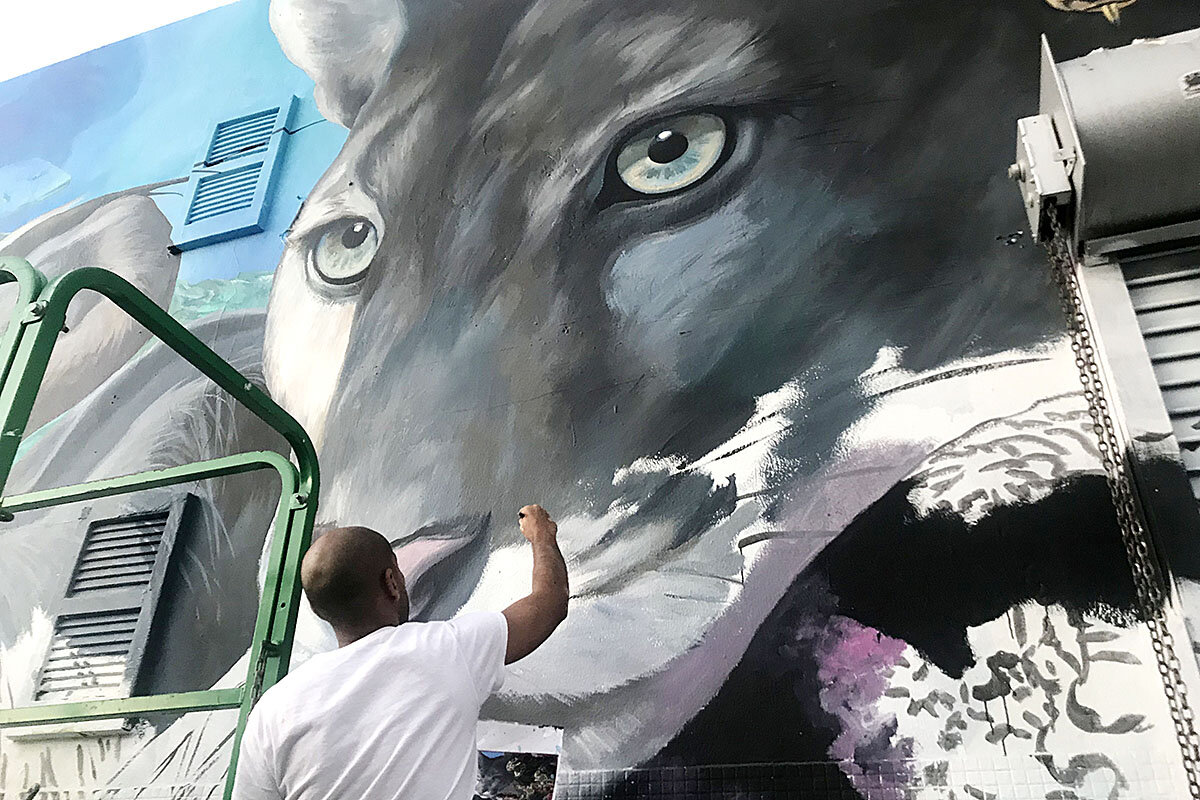Techno-charged street art brings climate change to life
Loading...
| Miami
The panther’s face dwarfs Reinier Gamboa as the painter calmly shades the animal’s snout in the light of the setting sun. Around the corner, passersby pause to snap selfies with a painted wolf. Wrapping around the sides of the building, the mural depicts a broad variety of animals and plants that reside in south Florida, from an endangered native orchid to the invasive Burmese python.
But the artwork isn’t just what meets the eye. Linda Cheung, the creative director of the project, holds up a tablet and frames it around a sea turtle at the center of one of the walls. Suddenly, another turtle swims across her screen. The mural is accompanied by an augmented reality app that, when the project is complete, will play videos about each animal when a viewer points a smartphone or tablet camera at it.
This project isn’t just about merging traditional forms of art with more modern ones. There’s a message hidden in this mural, revealed in the videos: The sixth mass extinction in Earth’s history is upon us, and it’s our job to make it stop. This is the second mural in a broader project of Ms. Cheung’s to provide a fresh lens on climate change.
Why We Wrote This
Discussions around climate change are often mired in heated political rhetoric. In Miami, a team of artists aims to cut through the rancor with a series of augmented reality murals.
Cheung, Mr. Gamboa, and their team are part of a growing contingent of climate activist artists. The arts, they say, can offer a visceral – and more accessible – space for the public to explore the topic of climate change without becoming mired in the complexities of the science and rhetoric of political discourse.
“Art is opening up an avenue for people to have their own feelings, to form their own opinions,” says Chantal Bilodeau, a playwright and founder of Artists & Climate Change. “It’s a very unique space that the arts can offer that doesn’t exist in a lot of other places.”
Inspiring self-reflection
Cheung hopes her “Miami Murals: Climate Awakening” project can help bridge the divide between climate activists and the general public. Too much climate activism happens in an echo chamber, she says. Miami has a strong arts culture and is already feeling the heat of climate change, so the city's mural-covered Wynwood neighborhood seemed a perfect setting to find a universal entry point into the topic.
The first mural in the series depicts the Miami skyline and shore, with letters spelling out the city’s name in the foreground. When viewers hold up their smartphone over that scene, they are offered a choice: Click “No change” or “Be the change.” If they select the former, the sea level rises, the skies fill with pollution, and the letters crumble and fall into the ocean. But if they choose “Be the change,” the scene gets brighter, and it becomes a green paradise.
Cheung’s goal is to inspire self-reflection. “At the end of the day, all of us play a role,” she says. “So we try to deal more with inspirational emotions versus shaming or finger-pointing.”
That sort of reflection is the essence of the arts, Ms. Bilodeau says. Art inherently invites viewers to consider their relationships to the content and see it through a unique lens.
“Science can tell us what’s happening,” she says. The arts “can weave facts together in a way that elicits emotional responses, which carry huge personal meaning.... When we start to understand facts as part of a bigger story and can relate to it emotionally, it takes on a whole different meaning.”
Democratizing discussion
Climate change is also often a politically fraught topic, which can make dialogue difficult. Some artists are embracing that, actively petitioning for change through protest art. But Cheung and her colleagues see the murals as a way to cut through the political din and remove preconceived labels.
“Art can deal with controversial issues in a more open way, in a more inclusive way,” says Dr. Paula Serafini, a research associate in the CAMEo Research Institute for Cultural and Media Economies at the University of Leicester in England. In a way, she says, it takes away the rules around who can participate in discourse and how.
Street art can be particularly successful in democratizing discussion, because it can draw the attention of people who may not seek out museums, plays, or other more formal artistic venues.
The hope, Cheung explains, is to encourage a cultural shift that empowers people to make small changes in their lives to help mitigate climate change.
But on a broader scale, art can help people to envision the kind of seismic shift that scientists say is needed to eliminate carbon emissions, says T.J. Demos, who teaches art and visual culture at the University of California, Santa Cruz.
“Art helps us reconceive terminology, ways of thinking, patterns of thought, cultural values, the fundamental bases of who we think we are, how we live in a community, how we define belonging,” he says. So images, stories, songs, and other forms of art can help people envision possible climate futures.
Art can also help humanity find emotional resilience in the face of such catastrophic change, Bilodeau adds.
“It’s scary, it’s overwhelming, and we have no choice but to accept that there are going to be huge losses. We need spaces to not only understand these feelings but also process them,” she says. “The arts can provide those spaces and perhaps, cathartic experiences that can help people grieve and get ready to embrace the work ahead.”







